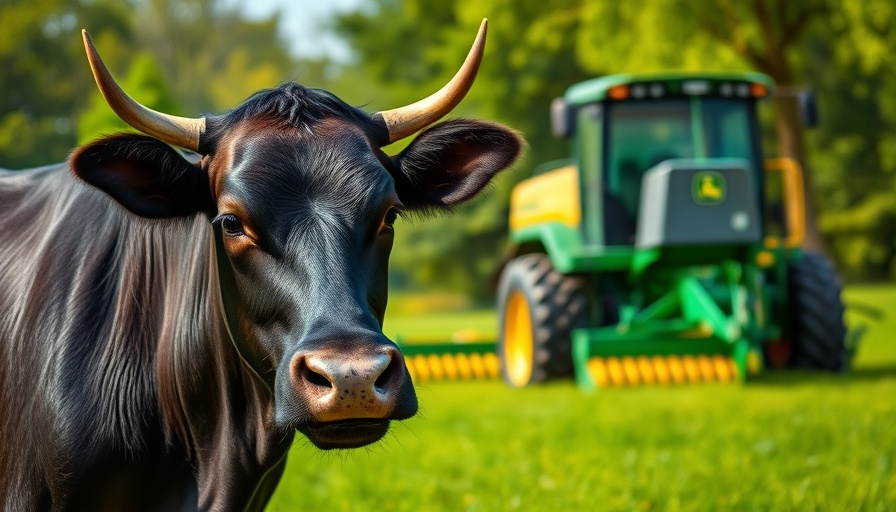
Understanding Agriculture Through the Eyes of the Next Generation
On a calm Friday morning, Marli Eeman, a recent hotel school graduate, shares her viewpoint on the agricultural industry as she begins her day at the Pilsvogel tapas bar and restaurant in Amsterdam. As she embarks on a new journey into business management this September, her perspective on farming and sustainability offers refreshing insights, especially as the agricultural sector faces mounting pressures related to climate change, food production, and societal expectations.
Farmers and the Stigma of Blame
Eeman emphasizes that farming is more than just a way to produce food; it is foundational to society. "The first thoughts I have when I think about agriculture are eating, livestock, fruits, vegetables, and the ongoing nitrogen issues," she explains. Her sentiments express a growing concern among young people about the burden placed upon farmers regarding environmental problems.
She argues that farmers should not bear sole responsibility for addressing issues like emissions. "Farmers are doing their best, but sustainability isn't always feasible—it's costly,” Eeman says, highlighting the financial hurdles farmers face in implementing greener practices as they attempt to navigate governmental regulations and market pressures.
The Economic Backbone of The Netherlands
Eeman's take on agriculture reflects a larger sentiment—recognition of its economic vitality. She maintains a positive outlook, noting that agriculture remains crucial for the Netherlands, especially concerning exports. "Farmers will always be needed," she states, reinforcing the importance of agriculture not just for the local economy but for global markets as well. However, she also points to the dichotomy of how farmers are perceived in light of recent protests against stringent regulations which have shed light on their struggles.
Navigating the Urban-Rural Divide
A significant element in her perspective is the perceived gap between urban and rural lifestyles. While Eeman admits that she is not frequently in rural areas, she observes that increasing consumer consciousness about where their food comes from is helping to bridge that divide. "People are becoming more thoughtful about local purchasing," she notes, referring to market shopping as a way to connect consumers directly with producers.
Eeman believes that further alleviating this urban-rural divide would benefit society as a whole. "We need to encourage popularity in buying from local farmers and businesses. This connection is vital for fostering a more supportive food system," she passionately states.
Shifting Perspectives and Building Connections
The recent farmers' protests have undeniably raised awareness about the challenges that farmers face, prompting more constructive dialogues about agriculture in society. Eeman observes an overall positive shift, noting, "More people have become aware of the difficulties faced by farmers since the protests began. It has fostered a better understanding of their daily struggles." This change in awareness may be the first step towards community support and policy change that benefits farmers and the environment equally.
Taking Action for Agricultural Sustainability
Addressing the need for shared responsibility in sustainability, Eeman advocates for a collaborative approach across all sectors. “Why do oil companies still receive substantial subsidies? The agricultural sector is making strides, but improvement must involve all industries sharing the load,” she argues.
This sentiment resonates with a larger trend of conscious consumerism, as consumers are increasingly prioritizing sustainability in their purchasing decisions. By supporting local, sustainable practices, consumers can actively contribute to the solution.
Conclusion: The Future of Farming in a Changing World
As the next generation looks towards the future of agriculture, understanding the complexities of food production and environmental sustainability is paramount. Marli Eeman's insights underscore the importance of connecting farmers, producers, and consumers in ways that elevate and support sustainable practices. The challenges they face are longstanding, but the willingness to engage in dialogue—coupled with a shared sense of accountability—can lead to fruitful outcomes for both farmers and society.
As stakeholders in the food system, from policymakers to everyday consumers, we all play a role in fostering an environment where farmers are supported—not burdened. It is essential to recognize the importance of collaboration across sectors and take actionable steps towards a sustainable agricultural future.
 Rij toevoegen
Rij toevoegen






Write A Comment